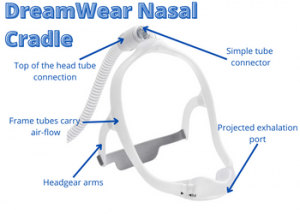- By Clay Rollyson
- /
- /
It always reeks of a “sales pitch” when a company tells you that you need to buy more of what they sell. So, in this blog I am going to do my best to keep the sales part down and the information part up. The fact of the matter is that you MUST change parts on your CPAP from time to time to avoid significant issues. Most of the issues caused by procrastinating on this maintenance are slow creeping issues. You may not even notice that they are becoming issues until you have a big issue. There are 3 things in my opinion that must be changed out regularly. Mask Seal, CPAP filter and CPAP tubing. Let’s dive deeper on each below.
Continue reading...
When to change out your CPAP Mask seal:
The mask seal is probably the most critical component of your CPAPs functionality. If you have a bad seal, you will have bad therapy. This is for a lot of reasons but is especially serious when you are on an Auto CPAP. Which MANY CPAP users are these days. That is because when the mask doesn’t seal the CPAP tries to make up for the leak by increasing airflow. Which almost always creates a worse leak. This snowballs until you call your provider and tell them that the CPAP isn’t working. To avoid this issue changing out the mask seal before it goes bad is the best bet. So how do you know when?1) Are you tightening your CPAP Mask headgear more?
The first sign of a CPAP Mask seal going bad is the tightening of the headgear. For over a month your mask has sealed really well, and now you are having to tighten the headgear a bit more every other night. This is almost certainly because the seal is beginning to wear out. When the silicone on the mask seal starts to deteriorate, it gets flimsy and starts to leak. To account for this leak, you pull the straps tighter on the mask. It solves the issue for tonight, but just returns in the nights to come. Eventually, you cause yourself abrasion issues on the high-pressure points and have to go a few nights without CPAP while the bridge of your nose heals. All of this would have been avoided if you had just changed out that seal when you noticed the first sign of leaking.2) Are your Therapy reports getting worse?
Almost all CPAP machines have an app or an ability to report your CPAP therapy statistics. To learn more about those reports visit our therapy report blog here. Most of those reports will give you a “leak” rating. You will notice that rating stays pretty steady when you are doing well on your CPAP. Then, just like the headgear issue, it begins to slide. You will notice that the leak LPM may go up gradually or that your Mask Seal score is going down. This is your opportunity to avoid the critical failure and get a new mask seal.3) Having trouble sleeping in your normal position?
When you first started with your new favorite mask you were sleeping so well in that favorite position. Now, you get there and wake up to your spouse poking you because your mask is whistling. You have to ask yourself, “what has changed?”. It is almost always the seal. Therapy pressures typically stay pretty similar once you get settled in on your CPAP. So, while you might think it is the CPAP changing and causing the issue, it is most likely not.4) Is your CPAP Pressure getting too high?
This is probably the most difficult issue we face when CPAP users procrastinate on changing out the seal. A TON of CPAP users are on Auto CPAP. Click here to learn what “Auto CPAP” is. When you are on Auto CPAP the CPAP will adjust the pressure to account for your apnea. It will also attempt to account for leaks in the same way. This means that when your mask seal goes bad, the CPAP may increase pressure to account for the leak. This in turn makes the leak worse and worse. The worst part about this issue is that even after you resolve the leak by changing out the seal, you still may have a few nights before the pressure comes back down on the Auto-CPAP.When to change out your CPAP filter:
This is by far the simplest and cheapest thing that you have to maintain on your CPAP. Failing to maintain the filter is also the number one reason why CPAPs fail. There is no reason not to change out your CPAP filter at least once per month. They are a couple dollars at most and take 2 seconds to change out. I recommend checking them weekly to look for discoloration and to change them as soon as you see any dust or dirt. For people with pets this is especially important. You do not even realize how much pet dander is in the air, and that CPAP filter is catching it all.What happens when you don’t change the CPAP filter?
If you leave a dirty filter in the CPAP, it will get worse and worse until the CPAP cannot even pull enough air to maintain your proper pressure. Time and time again we have customers come in saying that the CPAP isn’t blowing enough anymore. We open the filter door and call the hazmat team to remove the black filter inside. Then the CPAP is working again. Not only can the dirty filter cause therapy issues, but it will eventually destroy the CPAP motor. Like any motor, the CPAP motor works well when it is able to move freely. When it is strained it causes issues. You will usually notice some groaning coming from the CPAP at first, then it gets louder. At this point the CPAP is shot and will need to be repaired or replaced. Check out our CPAP repair blog for more details on that.When to change out your CPAP Tubing?
This is another part that is pretty inexpensive to change out. As long as you are using regular CPAP tubing. If you are on heated tubing it can be more expensive. If you aren’t sure that you should be on heated tubing, check out our blog discussing that topic here. My sole recommendation on the CPAP tubing is to have an extra one on hand. It simply cannot hurt to have an extra. The signs of needing to change out the tubing in advance of it failing are pretty simple:Signs of it being time to change the tubing:
- Mask will not stay attached
- Breaks or tears in the tubing
- Stretched plastic at the connection point
- Tubing is pulling lose from the CPAP
- Heated tube is no longer humidifying me






















